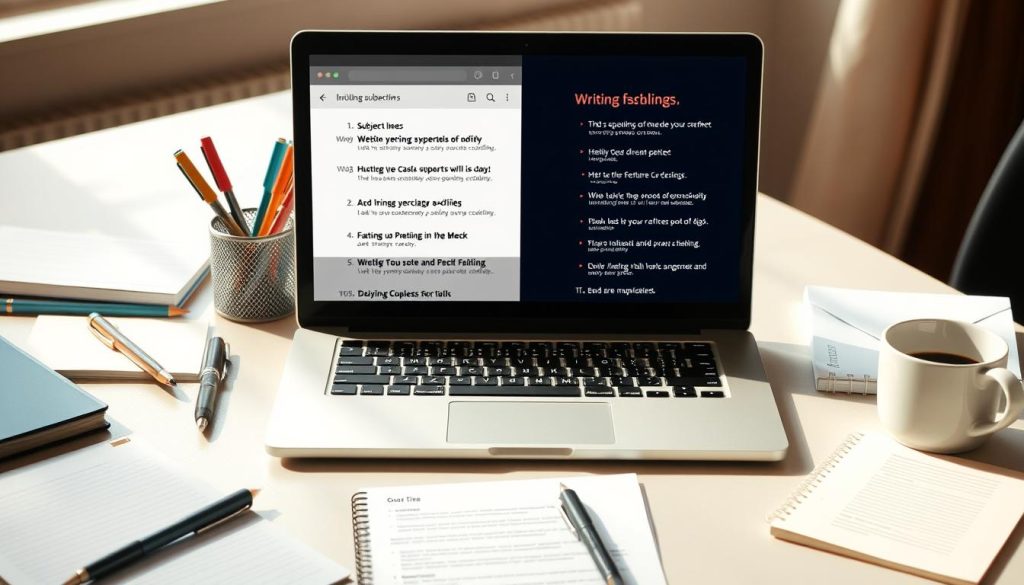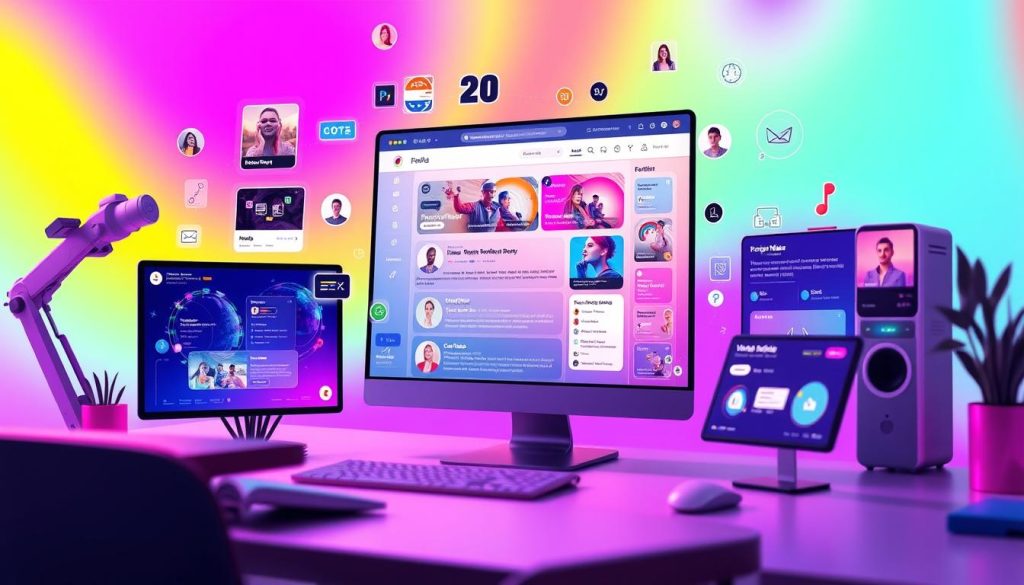In the fast world of startup funding, getting Series B investment is a big deal. Cold emails are now a key way to draw in investors. This guide will show you how to write messages that grab the attention of potential backers. This can help you get the Series B funding you need.
We’ll look at the Series B funding scene today. You’ll learn how to build a list of investors and make cold emails personal. By using these strategies, you can catch the eye of venture capitalists and grow your startup.
Key Takeaways
- Cold emails are effective for attracting Series B investors
- Understanding the 2024 funding landscape is crucial
- Crafting compelling subject lines increases email open rates
- Personalization at scale improves investor engagement
- Proper timing and follow-up strategies boost response rates
- Compliance with email regulations is essential
Understanding Series B Funding Landscape in 2024
The Series B funding scene in 2024 is changing fast. Startups need to be careful as they look for this important funding. The process is more detailed than ever before.
Current Market Dynamics and Investor Preferences
In 2024, investors want startups with proven business models and growth potential. They look for companies that can grow big and make money. Investors are interested in startups with:
- Solid revenue growth
- Expanding customer base
- Efficient unit economics
- Strong leadership team
Key Differences Between Series A and Series B Expectations
Series B funding has higher standards than Series A. Series A is about starting, while Series B is about growing and expanding. Investors at this stage want:
- More mature product offerings
- Established market presence
- Clear competitive advantages
- Detailed growth strategies
Typical Series B Investment Sizes and Requirements
Series B investments have grown in size. In 2024, they usually range from $20 million to $60 million. Startups need to meet strict criteria to get these funds:
| Requirement | Typical Expectation |
|---|---|
| Annual Revenue | $5 million – $15 million |
| Growth Rate | 100% – 300% year-over-year |
| Market Size | $1 billion+ addressable market |
| Team Size | 20-50 employees |
Knowing the market, investor wants, and funding sizes is key for Series B startups. It helps them match their pitch and plan with what investors want. This way, they can better their chances of getting the money they need for growth.
Series B Investor Attraction Email Ideas
Creating compelling email templates is key for reaching out to investors. When aiming for Series B investors, your pitch must highlight growth and market success. Here are some email ideas to grab investor interest.
Begin with a catchy subject line that showcases your unique selling point. For instance: “AI-Driven Fintech Seeking Series B – 300% YoY Growth”. This line captures attention and sets the pitch’s tone.
In the email’s body, focus on metrics that Series B investors care about:
- Revenue growth
- Customer acquisition costs
- Market expansion plans
- Team expertise
Use clear language and bullet points to make your email easy to scan. Here’s a sample template structure:
| Email Section | Content Focus |
|---|---|
| Opening | Brief company introduction and funding goal |
| Traction | Key growth metrics and milestones |
| Market Opportunity | Addressable market size and growth potential |
| Team | Highlight of key team members and advisors |
| Call-to-Action | Request for meeting or pitch deck review |
Personalize each email by mentioning the investor’s portfolio or recent investments. This shows you’ve researched them and boosts your chances of a positive reply.
“The best pitch emails are concise, data-driven, and tailored to the investor’s interests.”
By using these elements in your email templates, you’ll craft strong pitches. These will resonate with Series B investors and boost your outreach success.
Building a High-Quality Investor Email Database
Creating a strong investor email list is key for Series B fundraising success. It requires email verification, smart segmentation, and data enrichment.
Email Verification Best Practices
Email verification makes sure your list has real, active addresses. Use reliable tools to check address formats, domain status, and mailbox activity. Remove duplicates and update bounced emails to keep your list top-notch.
Investor Segmentation Strategies
Segmenting investors lets you tailor your approach. Group them by investment focus, fund size, or location. This makes your outreach more personal and boosts your chances of finding the right investor.
| Segment | Criteria | Outreach Strategy |
|---|---|---|
| Tech-focused VCs | Invest in SaaS, AI, blockchain | Highlight tech innovation |
| Large funds ($500M+) | Assets under management | Emphasize scalability |
| Local investors | Based in your region | Stress local economic impact |
Data Enrichment Techniques
Enrich your database with insights on each investor. Use social media, news, and professional networks to learn about their recent investments and interests. This helps you create pitches that really resonate.
- Track recent deals and exits
- Note board positions and advisory roles
- Identify shared connections or alma maters
By focusing on email verification, segmentation, and data enrichment, you’ll create a top-notch database. This is crucial for successful Series B outreach.
Crafting Compelling Email Subject Lines for Investors
Creating email subject lines that catch investors’ eyes is key for startups looking for Series B funding. A good subject line can mean the difference between an email being opened or not.
Psychology Behind High-Converting Subject Lines
Effective subject lines use psychology to their advantage. They spark curiosity, create a sense of urgency, or promise value. For emails to investors, showing growth or unique selling points can grab attention. Keep them short, clear, and relevant to stand out in a crowded inbox.

A/B Testing Strategies for Subject Lines
A/B testing is essential for improving email subject lines. Try different things like length, personalization, or numbers. Send two versions to a small part of your list, then use the best one for the main campaign. This method helps you refine your approach over time.
| Variable | Version A | Version B |
|---|---|---|
| Length | Short: “400% YoY Growth” | Long: “Our AI Platform Achieved 400% YoY Growth” |
| Personalization | Generic: “Series B Opportunity” | Personalized: “[Investor Name], Series B Opportunity” |
| Numbers | Without: “Breakthrough in FinTech” | With: “$10M ARR: FinTech Breakthrough” |
Avoiding Spam Triggers in Subject Lines
When reaching out to investors, avoiding spam is crucial. Don’t use all caps, too much punctuation, or words like “free” or “guarantee.” Stick to genuine, valuable content that shows respect for the investor’s time and space. This approach boosts your credibility and delivery rates.
Email Authentication and Security Measures
Keeping your email communications safe is key when you’re looking for Series B investors. Email authentication is a big part of this. It helps protect your messages and builds trust with the people you’re emailing.
There are three main email authentication methods you need for reaching out to investors:
- SPF (Sender Policy Framework): Checks if the sending server is allowed to send emails for your domain.
- DKIM (DomainKeys Identified Mail): Adds a digital signature to your emails. This shows they haven’t been changed while they were sent.
- DMARC (Domain-based Message Authentication, Reporting, and Conformance): Uses SPF and DKIM together. It tells others how to handle emails that don’t pass these checks.
Using these protocols stops email spoofing and phishing. This makes sure your emails get to investors safely. By setting up SPF, DKIM, and DMARC for your domain, you show you care about email security. This makes you look more credible to potential investors.
To start, talk to your IT team or email service provider about setting up these authentication methods. Keep an eye on your email authentication reports. This helps you find and fix any problems fast. With these steps, you’ll make sure your emails get through and keep your brand safe during your Series B fundraising.
Personalizing Cold Emails at Scale
Email personalization is crucial for grabbing investors’ attention. Tailoring your message to each recipient boosts your chances of a positive reply. Let’s dive into how to personalize cold emails effectively, reaching out to many investors.
Dynamic Content Integration
Dynamic content lets you customize your email with investor data. You can add personalized greetings, company names, or investment interests automatically. This makes each email unique and saves time.

Addressing Investor-Specific Pain Points
Research each investor’s portfolio and focus areas. Show how your startup solves their problems. This proves you’ve done your homework and makes your message more relevant.
| Investor Type | Common Pain Points | Personalization Strategy |
|---|---|---|
| Tech-focused | Scalability concerns | Highlight growth potential |
| Impact-driven | Social responsibility | Emphasize positive impact |
| Industry-specific | Market expertise | Showcase domain knowledge |
Custom Pitch Deck Integration
Integrate your pitch deck into your emails. Create versions for different investor profiles. This way, you present the most relevant information, boosting engagement and response rates.
By using these strategies, you can craft targeted emails that connect with Series B investors. The aim is to make each investor feel uniquely addressed, even when reaching out to many.
Timing and Follow-up Strategies
Getting the timing right and following up is key to attracting Series B investors. By perfecting your outreach, you can greatly increase your chances of getting that meeting.
Optimal Sending Times for Investor Emails
Timing is crucial for email outreach. Research shows Tuesday and Thursday mornings between 10 AM and 11 AM are best. This time frame helps your email get noticed when investors are most open to it.
Multi-Touch Follow-up Sequences
One email is not enough. A multi-touch follow-up sequence can make a big difference. Start with an intro email, then send 2-3 more, spaced 3-5 days apart. Each should share new, valuable info about your startup.
| Follow-up | Timing | Content Focus |
|---|---|---|
| 1st | 3 days after initial email | Key metrics and growth |
| 2nd | 5 days after 1st follow-up | Market opportunity and traction |
| 3rd | 5 days after 2nd follow-up | Team expertise and vision |
Response Rate Optimization
To get more responses, keep your emails short and to the point. Make each one personal with details for the investor. Use clear calls to action and offer different ways to connect. By tweaking these, you can make your email campaign much more effective.
Measuring and Analyzing Email Campaign Performance
Tracking email metrics is key for better investor outreach. By focusing on important campaign analytics, you can improve your strategy. This can help you get Series B funding.
Start by watching open rates to see if people are interested. A high open rate means your subject lines grab attention. Click-through rates show how interesting your content is. These metrics tell you what investors like.
Conversion rates show how well you’re doing. Track how many investors want to meet or learn more. This shows if your campaign is working towards funding goals.
“Email metrics are the compass guiding your investor outreach strategy. They reveal what works and what doesn’t, allowing for continuous performance optimization.”
Use A/B testing to make your campaigns better. Try different subject lines, email styles, and call-to-action spots. Then, see what works best and improve your strategy.
| Metric | Target Range | Optimization Strategy |
|---|---|---|
| Open Rate | 20-30% | Improve subject lines, sender name |
| Click-Through Rate | 2-5% | Enhance content relevance, CTA placement |
| Response Rate | 5-10% | Personalize content, follow-up strategy |
| Conversion Rate | 1-3% | Refine pitch, tailor to investor preferences |
Remember, always keep improving your strategy. Check your email metrics often and adjust as needed. This way, you’ll make your investor communications more effective. And you’ll have a better chance at getting Series B funding.
Legal Compliance and Anti-Spam Measures
When emailing investors, startups must follow the law. They need to stick to anti-spam rules and privacy laws. This keeps practices ethical and avoids fines.
CAN-SPAM Act Compliance
The CAN-SPAM Act guides commercial emails in the US. You must include your business address and a clear unsubscribe link in every email. Also, don’t use misleading subject lines and respect opt-out requests.
GDPR Considerations
For European investors, GDPR rules are key. You need to get clear consent before emailing and protect personal data. Be open about how you use data and let people access or delete their info.
Email Privacy Best Practices
Here are tips to build trust with investors:
- Use secure email servers and encryption
- Only collect data you really need
- Keep your privacy policy up to date
- Train your team on email privacy
By following these steps, you show you respect investor privacy. This boosts your chances of getting Series B funding while staying within the law.
Conclusion
Getting Series B funding through cold emails is key for startups looking to grow. By making emails personal and using data, companies can increase their funding chances. It’s all about knowing what investors want and matching your message to their needs.
Creating a strong bond with investors is more than just sending emails. You need to tell a story about your startup’s future and show solid numbers. Investors want to see businesses that can grow big and have already shown success. Your emails should show off your achievements and what’s coming next.
Also, remember to keep your emails safe and follow the law. Staying compliant with anti-spam laws and protecting data builds trust. As you work towards Series B funding, keep improving your email tactics based on how well they work. With the right effort and strategy, you can get the funding to make your startup soar.
FAQ
What is Series B funding, and how does it differ from Series A?
Series B funding is the second round of venture capital for startups. It’s different from Series A because investors look for more mature businesses. They want to see proven business models and significant traction.
Series B rounds are bigger, from million to million. They focus on scaling the company, not just getting it off the ground.
How can I build a high-quality investor email database?
To create a top-notch investor email database, start with email verification and segmentation. Use reliable sources for contact info and check email addresses for accuracy.
Segment investors by their focus and portfolio. Add more details about their preferences and past investments to enrich your data.
What are some effective email subject lines for attracting Series B investors?
Good subject lines for Series B investors are short, personalized, and focused on value. Try something like: “[Investor Name], Our 300% YoY Growth Might Interest You”.
Always test different subject lines and avoid spam triggers to get more opens.
How important is email authentication for investor outreach?
Email authentication is key for reaching out to investors. Using DMARC, SPF, and DKIM improves email delivery and security. It shows you’re professional and serious.
These steps help build trust with potential investors, which is crucial for Series B funding.
How can I personalize cold emails at scale?
Personalize cold emails by using dynamic content to insert investor-specific info. Address their unique interests or pain points based on their portfolio.
Make custom pitch decks for each investor. Use email marketing tools for advanced personalization and segmentation.
What are the best practices for following up with potential investors?
For follow-ups, create sequences with varied approaches over time. Provide more value or insights in each follow-up. Be persistent but respectful.
Optimize your timing based on response rates. Use tools for automated, personalized follow-ups.
How can I ensure my investor outreach emails are legally compliant?
Follow the CAN-SPAM Act for legal compliance. Use accurate header info, avoid deceptive subject lines, and include an opt-out option.
For international investors, consider GDPR. Always prioritize email privacy and get consent before adding investors to your list.
What key metrics should I track for my investor email campaigns?
Track open rates, click-through rates, response rates, and conversion rates. Also, monitor bounce and unsubscribe rates for list health.
Use these metrics to improve your email strategy and boost campaign success.
How can I improve my email deliverability to ensure my messages reach investors?
Improve deliverability by maintaining a clean email list and avoiding spam triggers. Send valuable, engaging emails consistently.
Implement email authentication protocols and use a reputable email service provider. Regularly clean your list to remove bad addresses.
What are some common mistakes to avoid when reaching out to Series B investors?
Avoid sending generic emails and failing to clearly state your value proposition. Don’t neglect to include key metrics and traction data.
Be careful not to be too pushy or aggressive. Also, avoid emails with grammar or spelling errors, as they harm your credibility.


